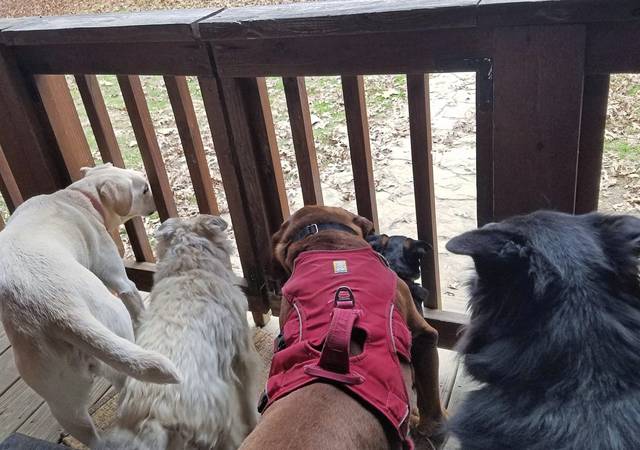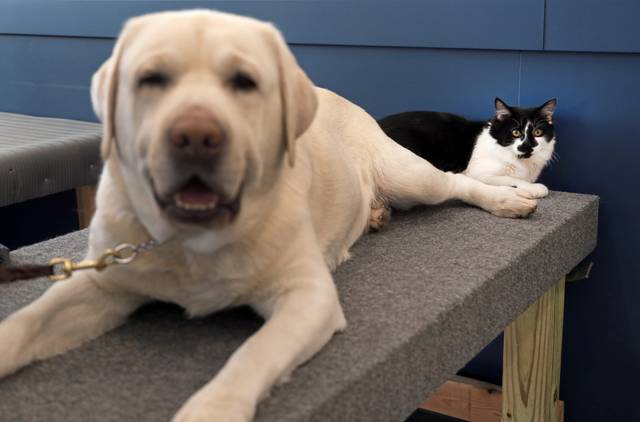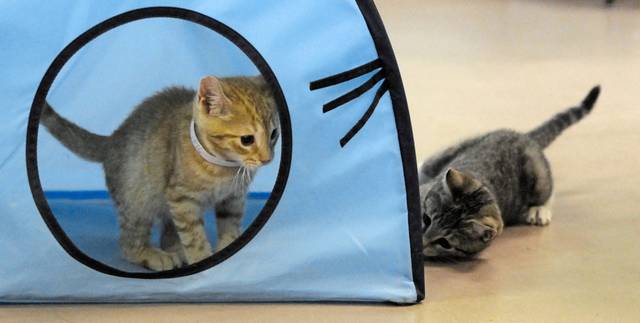Fighting like cats and dogs? Avoid conflict when adding a new pet
One is never enough when it comes to certain things: potato chips, pairs of shoes, friends who have your back.
For many animal lovers, one pet is certainly not enough, either. But it’s not a good idea to collect pets willy-nilly, like so many knickknacks.
Finances and lifestyle are two major considerations for anyone thinking about adding another pet to the home, says Aly Brown, a veterinary technician with the Humane Society of Westmoreland County.
Just because you think Australian shepherds are cute, for example, it doesn’t mean that breed is a good fit for you. It’s an active, energetic dog that needs a lot of stimulation and exercise and doesn’t necessarily do well in apartments.
“First, you need to do some research on the breed’s requirements,” Brown says, along with size, temperament, habits and other factors.
You also need to consider your household and your habits. If you work long hours and no one is home during the day, it might not be a good idea to adopt a puppy. A chill senior dog might be a better option.
“A puppy shouldn’t be left alone for more than four hours,” Brown says, for issues related to socialization and potty training.
“Most people don’t think about the cost of another pet,” she adds. “There’s the cost of food, the spay or neuter, the shots, regular vet care and emergencies.”
There also are the intangibles, Brown says.
“In the case of rescue pets, you don’t always know their history, and you just don’t know how it will go,” she says. “With the humane cases, there’s been abuse or neglect, and that is going to affect everything.”
Even if you have the space and resources to take good care of a menagerie, the animals themselves have their own thoughts, feelings and emotions that need to be taken into consideration. Not every pet is in the market for a new play buddy, but the situation can work if handled properly. Brown encourages owners to consider using a professional trainer to help pets acclimate to each other.
“A lot of them will come right to your house,” she says.
Here are a few things to consider before introducing a new cat or dog to a pet already in your home.
Introducing 2 dogs
We think of dogs as the quintessential pack animal — friendly, outgoing and accepting. But that doesn’t mean two dogs will be best friends upon first sniff.
1. Make the first meeting on neutral ground — outdoors is best. With each dog on a leash with a separate handler, let them approach each other from a distance.
2. Let the dogs determine the pace of the interaction. Don’t force them together.
3. Watch their body language. If you see raised hackles, bared teeth, growling or staring, try to distract the dog. Wait until things are calm and try again.
4. Reward them with verbal praise and treats for positive behaviors.
5. When you’re confident the dogs can come together safely in your home, continue to monitor them closely. Remove food, toys or other items they might fight over.
Source: humanesociety.org
Introducing 2 cats
Cat personalities run the gamut from solitary and aloof to affectionate and sociable. It can take up to a year for two cats to become friendly — or it may never happen. Some cats end up just avoiding each other. But, the more cats there are in a home, the more likely there is to be conflict.
1. If your cat is openly hostile when it sees another feline, it’s probably best not to adopt another cat.
2. If you do bring another cat home, let the two hear and smell each other before meeting face-to-face. Keep them in separate rooms and let them “meet” through a closed door.
3. After 2-3 days, switch their locations so they can investigate each other’s smells more closely. You also can give each cat an item that has the other’s scent on it.
3. If there’s been no hissing or growling after about a week, let them meet face to face, but separated if possible by a screen or baby gate.
4. Begin to allow them time together. Have the meetings follow meals or vigorous play time, when they are relaxed and happy.
5. Monitor interactions as necessary. If one cat continues to be aggressive, consider consulting an animal behaviorist.
Source: paws.org
Introducing a cat to a dog
Remember that some dogs view cats as prey. Dogs often just like to chase cats, who will be frightened and defensive. The size and strength differential also means that a playful dog can inadvertently injure or kill a cat.
1. Before you bring a cat home, your dog should obey basic commands like “sit,” “stay,” “down” and “come.”
2. Keep them in separate rooms and let them hear and smell each other through a closed door.
3. When they’re friendly through the door, bring them together for a short meet-and-greet, with the dog on a leash, sitting or lying down, and the cat on the other side of the room. Repeat several times until you are sure there will be no aggressive or hostile behavior.
4. With the dog leashed and sitting or lying down, let the cat explore him more closely. Reward the dog for good behavior. Make sure the cat has a hiding place or escape route.
5. Going forward, make sure the cat’s food and litter box are out of the dog’s reach. Dogs will snack on the contents of both, which can be disturbing to the cat (and, especially in the case of the latter, to the owner).
Source: paws.org
Introducing a dog to a cat
While the same basic methods apply to this situation as to bringing a cat into a home with a dog, there are some special considerations here. Cats tend to be more protective of their territory than dogs, so socializing can take much longer when the dog is the newcomer (or the interloper, in the cat’s view).
1. Herding and hunting breeds of dogs have higher prey-chasing instincts and are more likely to be aggressive toward cats.
2. Changes in the environment, like the introduction of a dog, can be very stressful to cats. They may stop eating or drinking, they may hide and they may do their business outside of the litter box (like on your bed).
3. The stress of bringing a dog into the home can shorten an older cat’s life span. Kittens generally will adapt better, and the best combination is to bring a puppy and kitten home at the same time — although that’s a lot of work.
4. The cat’s comfort and safety should be the highest priority — after all, seniority should count for something.
Source: waysidewaifs.org
Shirley McMarlin is a Tribune-Review staff writer. You can contact Shirley by email at smcmarlin@triblive.com or via Twitter .
Remove the ads from your TribLIVE reading experience but still support the journalists who create the content with TribLIVE Ad-Free.





